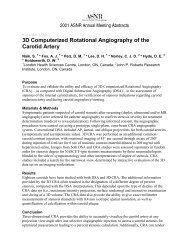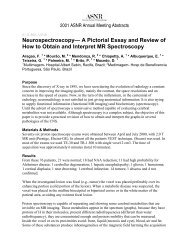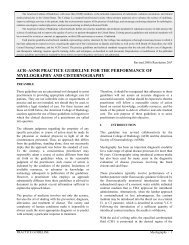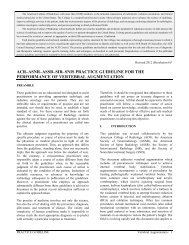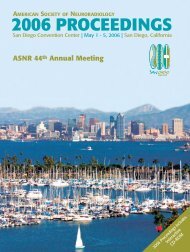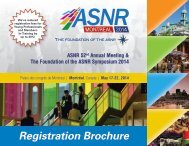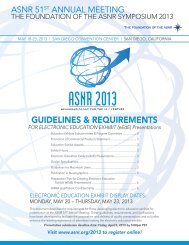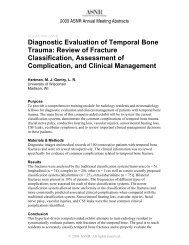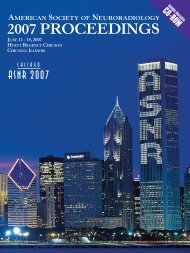MR Findings in a Family with Spastic Paraparesis ... - For Members
MR Findings in a Family with Spastic Paraparesis ... - For Members
MR Findings in a Family with Spastic Paraparesis ... - For Members
Create successful ePaper yourself
Turn your PDF publications into a flip-book with our unique Google optimized e-Paper software.
2003 ASNR Annual Meet<strong>in</strong>g Abstracts<br />
03-SPP-590-ASNR<br />
<strong>MR</strong> <strong>F<strong>in</strong>d<strong>in</strong>gs</strong> <strong>in</strong> a <strong>Family</strong> <strong>with</strong> <strong>Spastic</strong><br />
<strong>Paraparesis</strong> and Diffuse White Matter<br />
Disease<br />
Author(s):<br />
Agost<strong>in</strong>is, C. 1·Censori, B. 1·Partziguian, T. 1·Savoiardo, M. 2·Bizzi,<br />
A. 2·Bertagnolio, M. C. 2·Pareyson, D. 2·Bonaldi, G. 1<br />
1 Ospedali Riuniti, Bergamo, ITALY, 2 Istituto Neurologico, Milan, ITALY.<br />
Purpose<br />
Hereditary spastic paraplegia is a pathologic entity comprehend<strong>in</strong>g cl<strong>in</strong>ically and<br />
genetically different forms. We describe the peculiar <strong>MR</strong> f<strong>in</strong>d<strong>in</strong>gs of an Italian family<br />
affected by a severe form of hereditary spastic paraparesis.<br />
Materials & Methods<br />
Five of 7 offspr<strong>in</strong>gs of nonaffected consangu<strong>in</strong>eous parents of this family presented<br />
neurologic abnormalities: they underwent conventional <strong>MR</strong> exam<strong>in</strong>ation us<strong>in</strong>g a 1.5 T<br />
magnet. One patient had <strong>MR</strong> spectroscopy. A complete neurologic evaluation as well as<br />
neurophysiologic studies and metabolic tests also were performed.<br />
Results<br />
Diffuse <strong>MR</strong> abnormalities were documented <strong>in</strong> both the posterior fossa structures and<br />
cerebral hemispheres. White matter was predom<strong>in</strong>antly <strong>in</strong>volved, <strong>with</strong> diffuse T2<br />
hyper<strong>in</strong>tensity <strong>in</strong> the centrum ovale, <strong>in</strong>ternal capsule, and cerebellar peduncles<br />
(particularly the superior). The periaqueductal area was also abnormal. Thalami, basal<br />
ganglia, and perirolandic gyri appeared hypo<strong>in</strong>tense on T2 sequences.<br />
Conclusion<br />
Although the metabolic workup did not show abnormalities we considered it of <strong>in</strong>terest to<br />
report this family for the surpris<strong>in</strong>g homogeneity of the neurologic f<strong>in</strong>d<strong>in</strong>gs and the<br />
peculiar <strong>in</strong>volvement of some structures which might suggest a mitochondrial<br />
encephalopathy.<br />
References<br />
1. F<strong>in</strong>k JK, Heiman-Patterson T. (for the Hereditary <strong>Spastic</strong> Paraplegia Work<strong>in</strong>g Group).<br />
Hereditary spastic paraplegia: Advances <strong>in</strong> genetic research. Neurology<br />
1996;46:1507-1514<br />
2. Riggs JE, Ellis BD, Hogg JP, et al. Acute periaqueductal syndrome associated <strong>with</strong><br />
the G11778A mitochondrial DNA mutation. Neurology 2001;56:570-571<br />
© 2003 ASNR. All rights reserved.
2003 ASNR Annual Meet<strong>in</strong>g Abstracts<br />
3. Turp<strong>in</strong> J-C, Gray F, Baumann N. Leukodystrophies. In: Encyclopedie Médico-<br />
Chirurgicale. Vol. 5 Paris: 17-76-D-10,1-16<br />
© 2003 ASNR. All rights reserved.



